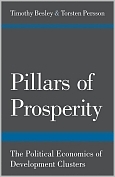"Little else is required to carry a state to
the highest degree of opulence from the lowest barbarism, but peace, easy taxes, and a
tolerable administration of justice; all the rest being brought about by the natural
course of things." So wrote Adam Smith a quarter of a millennium ago.
Using the tools of modern political
economics and combining economic theory with a bird's-eye view of the data, this book
reinterprets Smith's pillars of prosperity to explain the existence of development
clusters--places that tend to combine effective state institutions, the absence of
political violence, and high per-capita incomes.
To achieve peace, the authors stress the avoidance
of repressive government and civil conflict. Easy taxes, they argue, refers not to low
taxes, but a tax system with widespread compliance that collects taxes at a reasonable
cost from a broad base, like income. And a tolerable administration of justice is about
legal infrastructure that can support the enforcement of contracts and property rights in
line with the rule of law. The authors show that countries tend to enjoy all three pillars
of prosperity when they have evolved cohesive political institutions that promote common
interests, guaranteeing the provision of public goods. In line with much historical
research, international conflict has also been an important force behind effective states
by fostering common interests. The absence of common interests and/or cohesive political
institutions can explain the existence of very different development clusters in fragile
states that are plagued by poverty, violence, and weak state capacity.
Timothy Besley is the Kuwait Professor of Economics and Political
Science, and director of the Suntory and Toyota International Centres for Economics and
Related Disciplines at the London School of Economics and Political Science. Torsten
Persson is the Torsten and Ragnar Soderberg Chair in Economic Sciences and professor of
economics at the Institute for International Economic Studies, Stockholm University.
Table of Contents
Series Foreword ix Preface xi
CHAPTER 1: Development Clusters 1
1.1 Salient Correlations 6
1.2 The Main Questions 10
1.3 Fiscal Capacity 11
1.4 Legal Capacity 14
1.5 Political Violence 22
1.6 State Spaces 27
1.7 Development Assistance 31
1.8 Political Reform 32
1.9 Main Themes 34
1.10 Final Remarks 37
1.11 Notes on the Literature 38
CHAPTER 2: Fiscal Capacity 40
2.1 The Core Model 45
2.1.1 Basic Structure 46
2.1.2 Politically Optimal Policy 50
2.1.3 Fiscal-Capacity Investments 52
2.1.4 Normative Benchmark: A Pigouvian Planner 54
2.1.5 Three Types of States 56
2.1.6 Taking Stock 63
2.2 Developing the Model 64
2.2.1 Microfoundations for Fiscal Capacity 64
2.2.2 More General Models for Public Goods 67
2.2.3 Polarization/Heterogeneity 70
2.2.4 Income Inequality 73
2.2.5 Differences in Group Size 78
2.2.6 Tax Distortions 79
2.2.7 From Trade to Income Taxes 83
2.2.8 An Infinite-Horizon Model 86
2.3 Empirical Implications and Data 91
2.4 Final Remarks 99
2.5 Notes on the Literature 99
CHAPTER 3: Legal Capacity 103
3.1 The Core Model with Legal Capacity 108
3.1.1 Politically Optimal Policy 109
3.1.2 Investments in State Capacity 110
3.1.3 Comparative Statics 113
3.1.4 Taking Stock 117
3.2 Developing the Model 118
3.2.1 Microeconomic Foundations 118
3.2.2 The Genius of Taxation 131
3.2.3 Private Capital Accumulation 138
3.2.4 Predation and Corruption 144
3.3 Empirical Implications and Data 156
3.4 Final Comments 164
3.5 Notes on the Literature 165
CHAPTER 4: Political Violence 169
4.1 The Core Model with Political Violence 175
4.1.1 Model Modifications 175
4.1.2 Policy 177
4.1.3 Investments in Political Violence 179
4.1.4 Empirical Implications 185
4.2 Developing the Model 189
4.2.1 Asymmetries 189
4.2.2 Polarization, Greed, and Grievance 190
4.2.3 Anarchy 191
4.2.4 Conflict in a Predatory State 192
4.2.5 Investing in Coercive Capacity 193
4.3 From Theory to Empirical Testing 194
4.4 Data and Results 198
4.4.1 Data 198
4.4.2 Cross-Sectional Correlations 201
4.4.3 Econometric Estimates 202
4.5 Final Remarks 211
4.6 Notes on the Literature 213
CHAPTER 5: State Spaces 215
5.1 State Capacity in the Comprehensive Core Model 216
5.1.1 Equilibrium Political Turnover 216
5.1.2 Investments in State Capacity Revisited 219
5.2 Developing the Model 223
5.3 Empirical Implications 227
5.4 Putting the Pieces Together 231
5.5 Final Remarks 234
5.6 Notes on the Literature 235
CHAPTER 6: Development Assistance
237
6.1 The Core Model with Aid 242
6.1.1 Cash Aid 243
6.1.2 Technical Assistance 250
6.1.3 Military Assistance 253
6.1.4 Postconflict Assistance 254
6.2 Final Remarks 256
6.3 Notes on the Literature 257
CHAPTER 7: Political Reform 259
7.1 The Core Model and Political Reform 264
7.1.1 Political Reform under a Veil of Ignorance 265
7.1.2 Strategic Political Reform 267
7.2 Developing the Model 271
7.2.1 Micropolitical Foundations for ? 271
7.2.2 Micropolitical Foundations for ? 275
7.2.3 Constitutional Rules 280
7.2.4 Political Violence 282
7.2.5 Trust 287
7.2.6 Governance 290
7.3 Political Reform in Practice 293
7.4 Final Remarks 298
7.5 Notes on the Literature 299
CHAPTER 8: Lessons Learned 302
8.1 What We Have Learned 303
8.1.1 Answers to the Three Main Questions 303
8.1.2 Our Analysis and Traditional Development Research 307
8.2 The Pillars of Prosperity Index 310
8.2.1 Defining the Index 310
8.2.2 Predicting the Index 319
8.3 Where Next? 325
8.4 Concluding Remarks 332
References 333
Name Index 357
Subject Index 363
432 pages, Hardcover
Księgarnia nie działa. Nie odpowiadamy na pytania i nie realizujemy zamówien. Do odwolania !.


